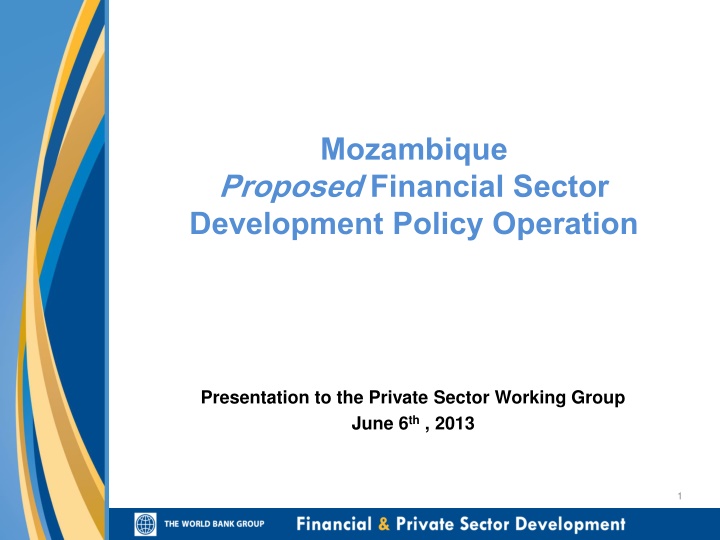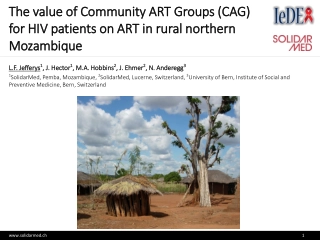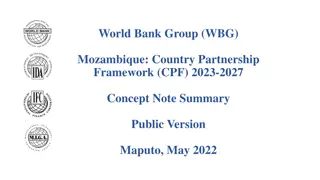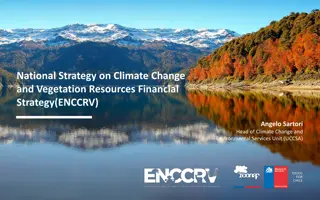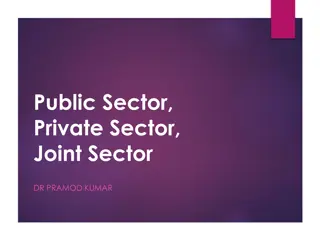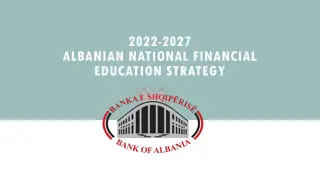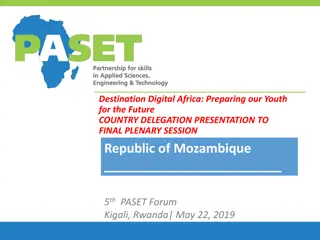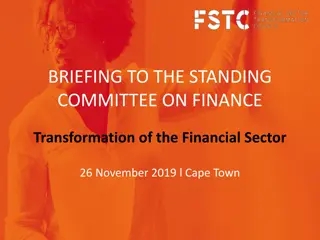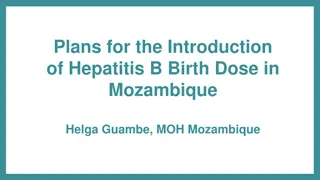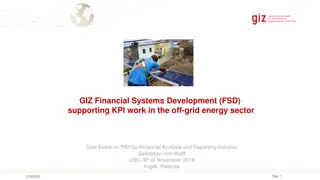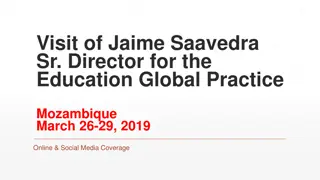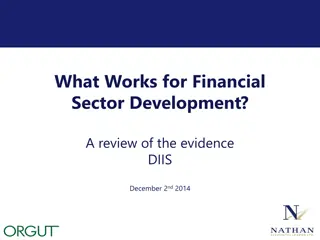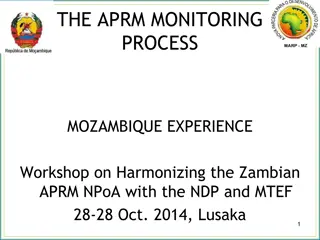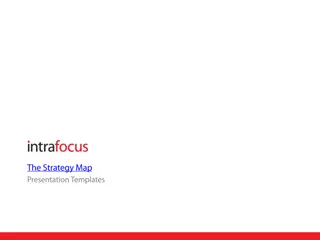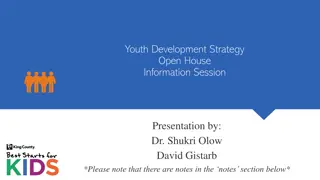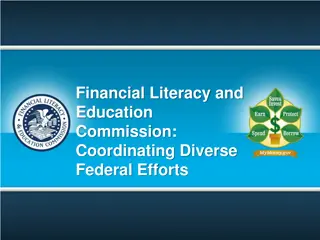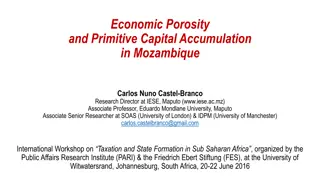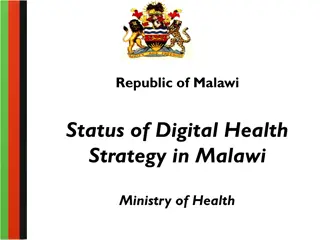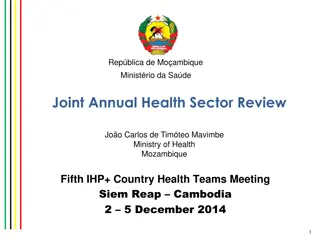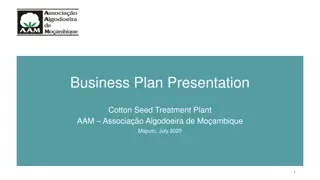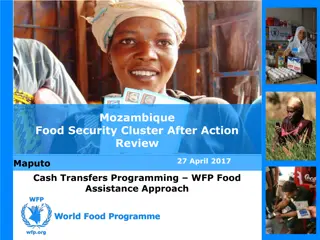Mozambique Financial Sector Development & Strategy
The presentation outlines Mozambique's proposed Financial Sector Development Policy Operation, highlighting key features of the financial sector, government's strategy for 2013-2022, recent bank-supported projects, and the focus on stability, access, innovation, and inclusivity.
Uploaded on Apr 04, 2025 | 1 Views
Download Presentation

Please find below an Image/Link to download the presentation.
The content on the website is provided AS IS for your information and personal use only. It may not be sold, licensed, or shared on other websites without obtaining consent from the author.If you encounter any issues during the download, it is possible that the publisher has removed the file from their server.
You are allowed to download the files provided on this website for personal or commercial use, subject to the condition that they are used lawfully. All files are the property of their respective owners.
The content on the website is provided AS IS for your information and personal use only. It may not be sold, licensed, or shared on other websites without obtaining consent from the author.
E N D
Presentation Transcript
Mozambique Proposed Financial Sector Development Policy Operation Presentation to the Private Sector Working Group June 6th, 2013 1
KEY FEATURES OF THE FINANCIAL SECTOR Banks continue to dominate the financial sector and the banking sector remains concentrated, despite increasing number of entrants, with the three largest banks owning 85% of banking sector assets Recent indications reveal notable progress in financial sector outreach: significant increases in number of bank branches, ATM, and bank accounts Nevertheless, financial inclusion remains generally low and lack of access to financial services outside Maputo and in rural areas is particularly acute Formal Microfinance has been focused in urban areas with stagnating growth; private insurance and pension sectors are still emerging; and capital markets are at nascent stage. The constraints to access to finance include both economy wide structural dimensions as well as specific financial sector challenges 2
Governments Financial Sector Development Strategy 2013-2022 Provides a comprehensive and detailed road map for financial sector development Builds on the findings of the Financial Sector Assessment Program Effort led by Ministry of Finance and complements other Government Strategies Strategy Objectives: (i) Maintain Financial Sector Stability (ii) Promote universal financial access (iii) Increase the supply of private capital by enabling public-private partnerships and developing the capital markets. Approved by the Council of Ministers on April 9 Will be formally launched at a Seminar on June 21 to be presided over by the Minister of Finance 3
Financial Sector Development Strategy 2013-2022 INCLUS O CONCORR NCIA INOVA O ACESSO 4 ESTABILIDADE
Recent Bank Supported Projects in the Financial Sector Financial Sector Technical Assistance Project (FSTAP) Multi-donor project (AFDB, WB, KFW, GIZ) WB financed components focused on: (i) Strengthening Central Bank Capacity; (ii) Introduction of IFRS in banking/corporate sectors; (iii) Improving Public Debt Management; (iv) Strengthening Financial Sector Infrastructure Other donor components focused on microfinance, SME finance, insurance, pensions, AML, and property registries WB financed components concluded in June 2012 and project was rated Moderately Satisfactory Other recent initiatives: report on Consumer Protection/Financial Literacy 5
Financial Sector Development Policy Operation Aims to support the reforms envisaged under the Government s Financial Sector Development Strategy Provides a mechanism for prioritization and sequencing of reforms Will be a Budget Support Operation Will be accompanied by parallel and complementary technical assistance from the WB and other donors (DFID, IMF, IFC, KFW, GIZ, AFDB) Is proposed as a Series of two Operations: 2013 and 2014 Preliminary Budget Allocated: US$25 million/year Complements other Bank Budget Support Operations (PRSC, Agriculture) Is integral to Bank s Country Partnership Strategy for promoting Inclusive Growth 6
Financial Sector Development Policy Operation Pillars Pillar One: Financial Sector Stability Enhancing Banking Sector Supervision and Integrity, Strengthening Safety Nets and Crisis Management Frameworks Policies to be supported include: improving risk-based supervision, establishing the deposit guarantee fund, and bank resolution mechanisms Pillar Two: Financial Sector Inclusion Improving access to financial services for firms and households Policies to be supported include: mobile banking regulations, credit bureau establishment, collateral and insolvency frameworks, transparency and consumer protection, and improving access to payment systems Pillar Three: Long Term Financial Markets Strengthening government debt markets and the insurance and pensions sectors Policies to be supported include: increased efficiency and competition in Government bonds, strengthened insurance and pensions regulations, and improved capital market regulations 7
Financial Sector Development Policy Operation: Next Steps Proposed Project Timeline for first DPO Identification Mission March / April Bank Concept Review- May Pre-Appraisal/ Appraisal Mission June / July Bank Regional Review- September Negotiations October Board Presentation November / December 2013 Key counterparts in Government: Ministry of Finance, Banco de Mocambique, Bolsa de Valores Board Approval contingent on achieving agreed upon policies Reform agenda ambitious but achievable: progress already noted 8
THANK YOU! Mazen Bouri mbouri@worldbank.org Rosario Marapusse rmarapusse@worldbank.org 9
